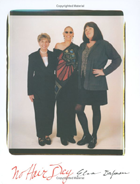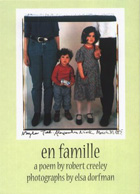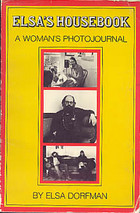9/11/01 by Mark Mirsky
9/11/01 by Mark Mirsky
At about 9:20 or so Inger and I went up on the roof to sit in our garden and go over some details of the next issue of the magazine. A neighbor was up there, with a stranger (who had come from two buildings over across the roofs) and in response to our question, what are you doing, since they were staring blankly to the southwest, they pointed mutely over the low roofs of Chinatown to the World Trade Center. When we turned, we saw the twin towers, upright against the far horizon, but in the center of a deadly calm-and with a rip in their patterned sides through which one stared . A brilliant blue sky surrounded the massive austere rectangles that dominated the landscape of Lower Manhattan, not a plane in sight, without the slightest movement nearby as if all was unnaturally calm and the strange black hole in the center of their silver spires was only a rent in a movie screen. The ribbons of orange flickering from white and grey curleycues of smoke appeared artificial. The scream of the ambulances had not really begun, so the Bowery which echoes normally to truck traffic cupped only the usual rumble that rocks our building, which has come to sound like the wash of the sea in the neighborhood’s ears. The sky was so intensely baby blue in the warm September sky that it back-lit these silver towers and the scrolls of black smoke and white that girdled a part of their slender forms. One clearly saw the holes where the planes had crashed in and the damage but how could we believe what we witnessed? Was it an illusion, the trick of some cinema projection.
“It was a mistake, a horrible miscalculation,” so the first reports that our neighbor was hearing on her little radio, plugged by a tiny speaker into one of her ears, told us. It was, however, inconceivable, that a pilot could not have seen the towers and so the first information on this radio that a controller had made a mistake just made the holes in the building, the black smoke pouring from it, and the flame licking the edges above and below the smoke, harder to believe.
“Two buildings, two planes making a mistake?” the landlord who had come up in the interim, after we banged on his door, running down, to alert everyone of what were seeing from our roof. “No, this is a terrorist attack.” And so it proved. What was awful was the hope, since the buildings seemed unshakable as the smoke and fire went on and on for over a half an hour after the planes crashed into them, that somehow they could reach the people stranded on those many floors above the collision. We stood there watching, trying to disbelieve, to repair the now opening rip in the silver spires, or call into play the idea of hope. Where were the rescue helicopters, or the fire hoses? The sky was empty, empty, far, far away one could see a helicopter but the buildings swam alone far beyond the city, gone already into another reality, even while they remained in this, so high above the rest of the city, abandoned by it, even the Woolworth building stranded leagues away. Over the radio, and from phone conversations, we heard that people were jumping from the windows, but we couldn’t make sense of the black hole, the abyss, into which they were fated to disappear. I went downstairs to to call my managing editor, gather up papers. If I ignored what I saw, perhaps I could keep them aloft. At 9:40 I still thought I could go up to City College and teach a class. By 9:50, with my briefcase in hand, and a tie around my neck, Inger, and my neighbors told me I was crazy to think I could get up there. The subways were shutting down and it seemed insane to try to get a taxi with people in real distress having to get uptown from the disaster. I was downstairs when the first tower fell, so was Inger, but on the roof to witness the second collapse. That was the most terrible and uncanny of moments for it pulverized before us in instants where formerly it had stood with its sibling, as if to defy the assault, in a partial sheet of smoke three quarters of the way up, the very edge licked by fire, but still intact both above and below where the plane had crashed through, still sleek, silvery, but already turning from an image of power into pathos. Before the moment that the first disappeared it seemed as if the structures would survive. I saw the second tower crumble a second after the explosion, though again, there seemed to me little noise, a slight rumble through the roof or perhaps the noise was swallowed up in the horror of the sight, the cloud of smoke and fragments, a sudden evil fireworks display, aluminum fragment shimmering like shooting stars. I had almost deliberately looked away, afraid to stare continually at the horror, as if that would somehow bring it on, my attention diverted, even as we heard on the radio that it was leaning, about to possibly crash. And Inger cried, “Oh my God, it’s collapsing.”
Then I heard, not a roar, but the cry of the ambulances as if there was some hope there and still hear them renewing again and again and through the morning and afternoon, now evening a silent queue of shocked people were making their way along the Bowery uptown. We are both numb. It seems outrageous having been this close to a catastrophe to continue with one’s work. Despite the sight of the towers so close, in flame, and the sight of one crumbling before one’s eyes I still can’t believe what has happened. The wind happily was blowing away from our buildings though ten blocks or so down the debris was caking the sidewalks. Cars from this zone, thick with the powder of the collapse, an ashen sand storm, came by from time to time. Had the wind shifted we all surely would have been driven, choking from the roof, the lofts, refugees joining the exodus below. This way we stood like Shaw’s characters, in the garden of Heartbreak House, watching the planes for World War One wing on their way overhead, as if in a stage set, our garden with blushing green and red apple trees, purple plums, golden grapes, the blue, blue background of a beautiful day, a hot sun, mocking the nightmare, the cloudless sky giving it a freakish clarity. Below us the trucks of this district, clogged the intersections, intent on their purposes and everyday errands, as the ambulances struggled to go uptown from the disaster, and maneuver around the big rigs that surged into the middle of the broad Bowery from narrow Hester Street, trying to beat the light, but stuck in the frozen line of traffic. At this corner, there were no policemen in sight while minutes now ticked into an hour since the collapse; and the trucks seemed to regard it as a normal day.
Across the sidewalks crowded with a long line of quiet refugees walking, since the subways had now shutdown and the buses were caught in the chaos from the downtown offices, streaming in business suits and office skirts up the Bowery and over the Manhattan Bridge, cartons of groceries were hauled. From our roof, I cursed this indifference but the sober lines of survivors, letting the cross sidewalk commerce pass, seemed to halt, as if reassured by the show of the normal business of the street.





